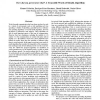Free Online Productivity Tools
i2Speak
i2Symbol
i2OCR
iTex2Img
iWeb2Print
iWeb2Shot
i2Type
iPdf2Split
iPdf2Merge
i2Bopomofo
i2Arabic
i2Style
i2Image
i2PDF
iLatex2Rtf
Sci2ools
CSE
2009
IEEE
2009
IEEE
How Did You Get to Know That? A Traceable Word-of-Mouth Algorithm
Word-of-mouth communication has been shown to play a key role in a variety of environments such as viral marketing and virus spreading. A family of algorithms, generally known as information spreading algorithms or word-of-mouth algorithms, has been developed to characterize such behavior. These algorithms are able to model important aspects of this type of communication. However, they have limitations, including the inability to: (1) capture when the communications or contacts take place and (2) explain where the influence comes from. These drawbacks have limited the studies about how the spreading of influence takes place in social networks. In this paper, we present a new word-ofmouth algorithm that considers the temporality of the communications and keeps track of how influence travels over the social network. We validate the proposed algorithm via simulations of word-of-mouth traces on call detailed records, in order to model how influence spreads. Our results indicate that (1) s...
| Added | 20 May 2010 |
| Updated | 20 May 2010 |
| Type | Conference |
| Year | 2009 |
| Where | CSE |
| Authors | Manuel Cebrián, Enrique Frías-Martínez, Heath Hohwald, Rubén Lara, Nuria Oliver |
Comments (0)

